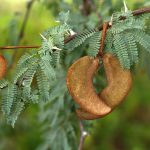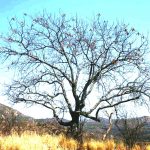TREE LIFE
FEBRUARY 1988
HARARE CALENDAR
Tuesday 2nd February: Botanic Garden walk. Meet in the Car Park at 4.45 for 5.00pm.
Sunday 20th February: Outing to Saffron Walden (off Lake Mcllwaine Road). This is an area of fascinating kopjies which we have visited before and always found richly rewarding, yielding a rich diversity of species. An Express Motorways coach will leave Monomatapa Car Park at 9.00 a.m. A security guard will look after vehicles left at the Car Park. Fare $6,00. Please book through Joy Killian an Harare Phone 308598.
Saturday 27th February: Mukuvisi woodlands meeting. Meet at 3.30 p.m. at Paget Road/Inyanga Crescent gate. Last month members and guests had a most instructive afternoon learning how to use Meg’s ‘Mukuvisi Woodlands key at the same time ironing out wrinkles before it goes to press. I’ve no doubt next meeting will be just as much fun.
Tuesday, 2nd March: Botanic Garden walk at 4.45 for 5 p.m.
MATABELELAND NOTES
Sunday, February 7th, we will go to The Matopos. Meet at Retreat at 0830 hours. The actual area will be arranged later.
- This will also be our long-overdue Annual General Meeting, and we must have a minimum of Officials to transact the Branch’s business, so come prepared!
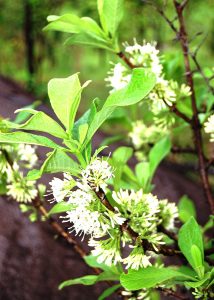
Pavetta schumanniana. Photo: Bart Wursten. Source: Flora of Zimbabwe
On Sunday, January 10th we went to Mr. McNeilage’e Farm, Kala Lute, part of the Kirtan Estate, near Heany. The country was deep rolling hills with plenty of water, the Ncima River Weir was overspilling, as were other Dams, and the river had recently been at least eight foot higher. This was the first overflowing river many of us had seen in many years. We expected afternoon rain, but it held off, and we botanized along the river area, and near-by High Ground, and then to some roadside kopje, with some rather faint Bushman Paintings and a good variety of trees. In all, we identified soon 62 species, several contrasting pairs, growing close to each other a teaching aid Acacia karroo and A. rehmanniana, Carissa edulis and C. bispinosa, Azanza garckeana and Dombeya rotundiolia, Clerodendrum glabrum and C. myricoides, Grewia bicolor, G. flavescens and G. monticoIa, Maytenus heterophylla and M. senagalensis, three Euclea, Euclea divinorum, E. undulata, E. natalensis, four Combretum, Combretum apiculatum, C. hereorense, C. imberbe, C. molle, three Rhus species, Rhus lancea, both large and very small R. pyroides, R. tenuinervis, Zanthoxylum capense and Z. chalybeum. We also saw Bauhinia thonningii, (Piliostigma), Ficus thonningii, F. sur (capensis), Dovyalis zeyheri, (clearly zeyheri because of the scalloped leaf margin), Ehretia rigida, Croton gratissimus, many leaves near the river were unusually large, perhaps due to the extra fertility of the flood silt; Parinari curatellifolia, Pappea capensis, Pavetta schumanniana, Peltophorum africanum, Pterocarpus rotundifolius, the young coppiced leaves of which were not unlike Bridelia mollis, also present, Diospyros lycioides was widespread, Ozoroa insignia subsp. reticulata, also, Tetradenia brevispicata, Terminalia sericea, Vitex payos, Ximenia caffra, some very pale some very dark green, Turraea nilotica and many of all sizes of Ziziphus mucronata.
-C.SYKES
SUNDAY. 17th January 1988: BUCKLAND ESTATE – PROPERTY OF MRS FIE VERWOERD
There was a good turn out for our first outing of 1988 in the Teviotdale area, and the greetings of ‘Happy New Year“ made it a festive occasion. Harare had had a heavy rainfall on the Saturday night and early that morning so it was a pleasure to start out with the sun shining, the grass underfoot not too wet, and though black rain clouds encircled us all day no rain had fallen by the time I left the venue.
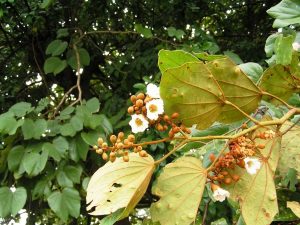
Bauhina thonningii. Photo: Jos Stevens. Flora of Zimbabwe
Our day’s leisurely reconnaissance was in riverine and woodland area. On approaching the former where we crossed a source of the Mazowe river, we found a good variety of trees on an anthill: Ziziphus mucronata, Cussonia arborea, Rhus longipes, Cassia singueana, Maytenus heterophylla and M. senegalensis, Diospyros lycioides and Cassine aethiopica, so this was a significant start. Kim gave us a dissertation on dioecious trees, those with male and female flowers on separate plants, and in this category the drab flowers, with sterile stamens and prominent ovary of the female Bauhinia thonningii which produces the legume (monkey bread) were contrasted with the showy flowers of the male tree with their plentiful pollen but aborted ovary and so unable to produce fruit. Another example of this was Uapaca kirkiana, the female bore the familiar fruit (the mahoboho) with its male counterpart nearby, fruit-less.
At the river’s edge was a strikingly tall Rhamnus prinoides in fruit, its horizontal branches held the glossy deeply veined leaves so cleverly arranged in four ranks, the bigger leaves bent back with smaller in front so as to get maximun light on their surface. Here, too, Vernonia subuliqera with its characteristic leaf-like stipules clasping the stalk and V. amyodalina lacking these stipules but with leaves having a purplish centre vein and margin finely toothed were two examples of the COMPOSITAE family that owes its extensive distribution (mainly as small plants, seldom as trees) to the fact that its flowers are the most highly developed in the plant kingdom.
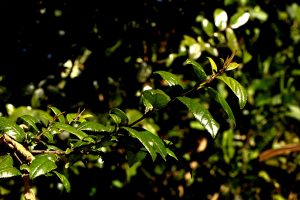
Rhamnus prinoides. Photo: Bart Wursten. Source: Flora of Zimbabwe
In both areas we noticed trees that had been ring barked, or where bark had been scraped off, apparently for medicinal purposes. The Ozoroa insignis had been scraped it appeared to be on one side only. Several Brachystegia spiciformis were ring barked to provide beehives, one of which we found at the base of a tree and we were intrigued at the way the wide strip of bark had been knitted together with wooden “prongs” to form a cylinder for the hive.
Dick, our chairman, had requested that at our outings this year we collect seeds to help in the regeneration of the fast dwindling supply of indigenous trees. In the miombo woodland there was a noticeable regrowth of Brachystegia spiciformis (from trees chopped down?) and thus it seemed a conservation effort was in progress.
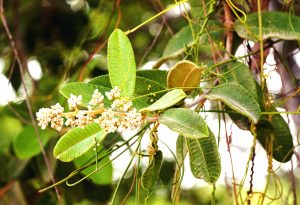
Ozoroa insignis. Photo: Bart Wursten. Source: Flora of Zimbabwe
The mnondo, Julbernardia globiflora was in flower as were many other trees :- Pittosporum viridiflorum, Indigofera erecta, Pavetta gardeniifolia, Massa lanceolata, (along the river) and Syzygium quinaenea which was already in fruit as was Combretum molle with it: bunches of brown 4-winged fruit. Two flowering plants came in for special mention l) Protea angolensis var. angolensis, a dwarf plant which we found spread over a large area and has not been seen previously on our tree outings. Positive identification is awaited from the Herbarium, when Meg’s whoops of joy will be louder! 2) Ziziphus mucronata, at head height, so we were able to examine the flowers and the pollinating agents, and found there to be five species of flies (one the common house fly). Flies pollinate the flowers of Maytenus senegalensis as well.
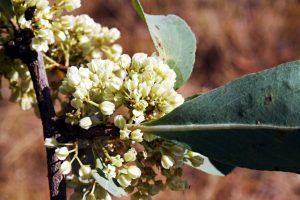
Maytenus senegalensis. Photo: Mark Hyde. Source: Flora of Zimbabwe
On the afternoon amble, to me the most exciting find was) Ziziphus mauritiana growing at the side of the road! It is from the ripe fruit of this plant that “Kachasu” is brewed, so in a somewhat lighthearted spirit, which indeed pervaded the company that day, and with a few leaves of Psorospermum febrifugum to provide a refreshing bath (ale Kim) I and this account, but not before we thank Mr. Verwoerd most sincerely for allowing us to wander over her lovely estate, which provided an ideal venue for the first outing of the year, and on which over 50 species of trees were identified.
-G.A. Granelli
BOTANIC GARDEN WALK TWELFTH NIGHT 1988
With all of them in full leaf Tom led us around the Commiphora. I have already written up their family, the BURSERACEAE in Tree Life No. 71 (January 1986). So I thought I’d take greater liberty with this article and describe what I’ve learned since then, or are worth repeating. And to do this lets begin with a trip to the Zambezi Valley. Here the genus Commiphora survives the long hot dry season and catches up during the rains. Just before descending into the valley the hills around Marongora have, a high density of Combretum mossambicense with its smooth bark the colour of deep rich honey. Their trunks are so distinctive they are easily spotted from a fast-moving car. This rocky environment in typical for these, they don’t grow on the Valley floor. Tom says they grow on all the schist hills. Scratching the bark or crushing a leaf releases the spicy/peppery smell.
At the base of the escarpment one can turn right to Mana Pools or left towards Kariba gorge. If you turn towards Kariba Gorge you have to close your eyes if you want to miss them! This road runs parallel to the escarpment most of the time and travels through a number of vegetation types. At one point this changes into a well-drained soil with small uneven stones (this indicates that the soil developed in situ from bedrock). This supports a tall closed-canopy forest of deciduous trees: with a dense under storey with many slender stems. On the large-scale maps this area is marked as Jesse and is also known as Jesse by the folk who work in the Valley. But it is not what Tom calls layered dry forest or Jesse – these occur on deep Kalahari-type sands with no stones in and the under-storey has a much more marked cut off point. Returning to the other forest the dominant trees seem to occur in patches, some areas have tall Terminalia prunioides, in others there are almost solid stands of gregarious trees like Kirkia acuminata. A few old baobabs squat in the woodland but there are patches just north of this road in amongst low hills where one can find hundreds (no exaggeration) of tall slender baobabs not much fatter than Tom’s 25 year old specimen in the botanic gardens. All of these completely undamaged by elephant, an unusual sight in the Valley today!
But the most notable feature of this forest are the tall ghostly trunks of C. caerulea. The fine papery yellow bark of this species peels back in large sheets to reveal the smooth blue-green under-bark. A walk in this tall forest is very dis-orientating. There happened to have been an elephant poached within a few hundred metres of the road and although the smell led the party to the elephant, you needed an excellent memory to get out again. The visibility is low even in the dry season and the many slender shrubs prevent the larger land marks from being seen. This is also excellent rhino country so besides the excitement of playing Hansel and Gretel there is a fair amount of adrenalin.
Another component of this forest is one of the grey twisted trunk Commiphora species. And here I must confess I am not sure which one it is if this is not true Jesse. I have generally assumed it to be C. karibensis and not C. mollis as it is so exceptionally fluted. We still do not have a fool proof way to separate these two when they are leafless, but while preparing the last article I observed that in the gardens C. karibensis secreted a copious translucent resin whereas C. mollis secretes a milky white resin. We slashed a few more trees this month and this hypothesis still stands although the sample size still includes only one C. karibensis. We would very much like someone to test this in the field, preferably when there are vegetative or floral features that confirm identification. According to the last article C. mollis grows on hillsides, rocky slopes and anthills, C. karibensis has a smoother, darker trunk and grows in Jesse. This one that grows in this mixed forest in the valley is remarkably gregarious although some of the patches have been severely flattened by elephant.
While teaching for the Mashonaland Hunter’s Association in the Zambezi Valley we often spend the last day of each camp going for a walk up one of the tributaries into the Zambezi Escarpment. This is such a change from the Valley floor, the steep rocky sides have different species of trees and the air is cooler. Many of these have permanent water and with their small local catchment areas some are free from bilharzia. Here we find the smooth paper bark C. marlothii. And it is often only here that students begin to accept that C. caerulea is blue-green whereas this is apple-green. I have realized that colours are a very difficult concept to teach, some are sensitive to the subtle differences, others are not, and the ability to recognise blue in green is such a valuable asset in our vegetation.
Other species which I have not seen in the Valley include C. merkeri, C. ugogensis, C. pyracanthoides, C. merkeri has a zebra striped bark and often grows in mopane woodland. C. ugogensis is apparently very conspicuously gregarious in Jesse although it is, I feel, one of the most difficult to identify without leaves. It is very spiny and the under bark is apparently a deeper green than other species.
For all the other species I cannot add more than already stated in the last article although Cheryl discovered that C. schimperi has a nauseating smell when a twig is broken off. C. neglecta is also peppery like C. mossambicensis. We must thank Tom for yet another valuable lesson, this is always a family worth a revisit.
-Kim St.J. Damstra
HIPPO POOLS – CHRISTMAS 1987
Hippo Pools is on the Mazowe River in the Umfurudzi Safari Area north east of Shamva. Needless to say there is fishing to be had and – yes – there are hippo. We watched seven at dusk making their way upstream to raid the fields of young mealies in the communal lands on the far bank. There were plenty of birds, including a Red Chested Cuckoo that went on calling all night.
The camp consists of three fully serviced chalets but not bed linen or towels, each of which can sleep up to six and which have an outside (but roofed) dining and sitting areas. There are camping sites available as well, and a communal toilet and ablution block.
If you are strong minded and can resist the temptation to stop every few kilometers to look at trees, it will take you an easy three hours to drive to the camp, all of which is on tar save the last 16 km. The latter is dirt, rough in places, due to erosion and impassable to buses due to a series of small river and stream beds with steep approaches and exits which would cause a long wheel base vehicle like a bus to bridge. For the average family saloon, no problem.
We knew that we were in for a few surprises as we drove through Colophospermum mopane woodland and the occasional Adansonia digitata. We were, in fact, in an area where the Highveld and Zambezi Valley vegetation meet. The size of the trees is impressive, indicating that the axe and chain saw has not yet arrived. During our few days there we kept on bumping into old friends and meeting complete strangers, many of which had us delving into Coates Palgrave far into the evening.
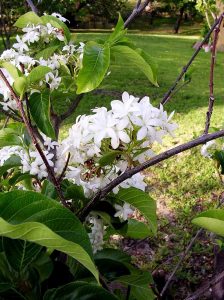
Holarrhena pubescens. Photo: Colin Wenham. Source: Flora of Zimbabwe
When we arrived at the camp and were waiting for the kettle to boil, we realized that we had Friesodielsia obovata, Tamarindus indica, Artabotrys brachypetalus and Holarrhena pubescens within touching distance. A short stroll within the camp area brought us to Ficus sycamorus, Trichellia emetica, Sclerocarya birrea, Stereospermum kunthianum and Dalbergiella nyasae.
In all we identified just under 100 species within 1km of the camp. Amongst the more interesting were Pterocarpus brennani, Phyllanthus engleri with spur shorts over 10 cm long, a beautiful Holarrhena pubescens covered in flowers, Olax dissitiflora in flower. Diospyros senensis, two Ficus abutilifolia over 20m tall, Ficus capreifolia down by the river, two striking Albizia tanganyicensis, Holmskioldia tettensis in flower, Acacia mellifera, Garcinia livingstonei, a wonderland, we think you will agree.
Of note were the number of seeds of Combretum adenogonium germinating. This species seems bent on a take over bid at Hippo Pools, but perhaps grazing hippo will keep them under control.
This camp would be a very interesting venue for a week-end outing, leaving Harare early Saturday morning and returning on Sunday afternoon. The cost is $25 per person per night but it is possible that a reduced rate could be negotiated for a large party. Members who would be interested in making up a party please tell a Committee member and we will see what can be done.
-D. Hicks
FIRST STEPS IN THE PROCESS OF IDENTIFICATION
- Always observe very carefully. Do not only look at one leaf or one twig or branch. There can be an amazing variation in leaf size and other details even on one tree.
- If you do not have a book to assist identification with you, note down your observations in a notebook. If you manage to get a specimen of the tree you are trying to identify, mark the leaf with a code, it is easy to write on most leaves with a ball point pen, to relate it back to the observations made in the notebook.
- Look at the shape of the tree.
- Look at the bark. Is it fissured? Does it peel away in strips? Does it have a particular pattern? Is it an unusual colour?
- If a leaf is removed, does it exude latex (milky substance)
- If the leaf is crushed between the fingers, does it have an unusual smell?
- Look carefully for thorns or spiky branchlets
- Look at the leaves. Are they simple or compound? Do they have an unusual shape or colour? Do they exhibit an unusual venation?
- Flowers can be a most useful aid to identification, especially if they are striking. Most botanical keys are based on the flower, but as flowers last only a relatively short time and one has to have a botanical background to be able to recognised the floral structure, using the flower as an identifying feature can be a problem.
- Fruit is a different matter. The type of fruit is more easily recognised –a pod or berry, etc. Furthermore, if the fruit is not completely eaten by birds and other animals, it can remain on the tree or the ground beneath the tree for a considerable time. So always check for any evidence of the fruit.
(Acknowledgements to Peltophorum No. 8, October 1987)
DICK HICKS CHAIRMAN


